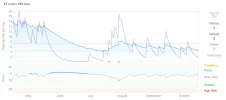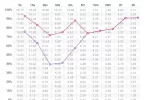I'm not an expert in this, but as I understand it, HCT dips during a long tour and mid way through, people will "top up". They'll come into the tour with a high HCT, use hydration to manipulate the testing to keep HCT roughly consistent in testing through the days when the transfusion occurs.
Specifically, It's the power at maximal fat oxidation that occurs just prior to LT1:
View attachment 298852
If one knows FTP, which is a surrogate for MLSS or LT2, then it's pretty easy to estimate Z2. Inigo San Millan recommends the talk test, which is to say that you should go at the greatest intensity you can sustain and still complete a sentence. That shouldn't feel "easy". One should be noticeably breathing, but there should be no "burn" and it should be a pace one can sustain for several hours.
It's probably a great idea from a health perspective. Once you have a month or two of data and a few maximal efforts, we can take a look at your power duration curve and see what kind of genetic talents you may have. In spite of not being a chicken legged climber, you might have a high absolute FTP which can be cool in things like flat time trials where W/CdA is more important than W/kg. It's also fun to be able ride into the wind and drop your skinny ass friends that always seem to want to drop you while climbing.
Just to be clear, because of the language difference, my comment about starting a war was a joke. It's a contentious topic in the cycling community.
If it's not obvious, I have a rather nerdy approach to "coaching". Mostly I helped people to train with power, do analysis, develop training plans, etc. There's a lot more to being a good coach than I was willing to do. It was only something I did for fun in any case.




